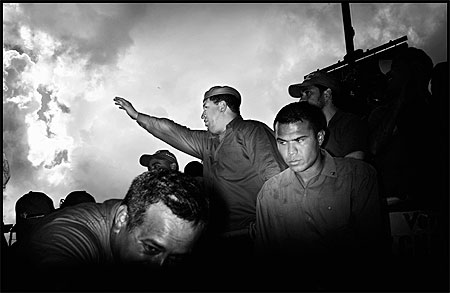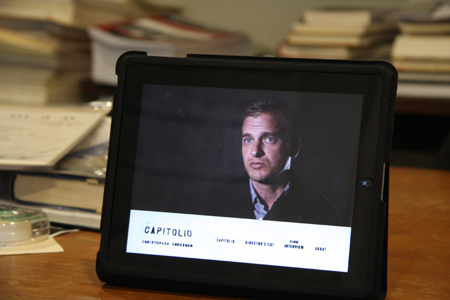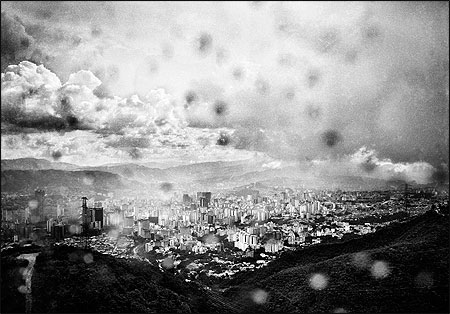
During the last decade Venezuela's "Bolivarian Revolution," led by President Hugo Chávez, has generated a plethora––of photographic images. It is not possible to think of my country without conjuring up images of mass protests and marches or, conversely, emblematic ones of its strongman, the still uncontested protagonist Chávez. Then there is also the violence and chaos inhabiting sections of Caracas, Venezuela's capital.
In "Capitolio," a book and an iPad app, Magnum photographer Christopher Anderson, connects the circumstances of Caracas's common folk with the failure of the country's urban modernization. It is in an almost religious sense that he portrays Caracas as a battlefield between the forces of good and evil. Images he uses to tell these stories exist in the difficult crossroads between photojournalism and art photography, between critique and propaganda: all of this is located somewhere in the middle between a critical vision and mystification.
To open the hardcover book is to confront a wall of images of poor Caracas neighborhoods, the barrios. The convoluted architecture of these disheveled dwellings speaks to the miserable existence of so many people living on the margins. Anderson contrasts such scenes of poverty with the skyscrapers of Caracas's Parque Central, which once were the tallest buildings in Latin America. He also compares them with the congested and badly maintained highways and with the Capitolio, the domed building that houses the national government, a radiant symbol of Venezuela's dysfunctional political system. All are emblematic of the betrayal of the promise of an abundant future fueled by petro-dollars.
Anderson portrays the collapse of modernity by showing the jungle atmosphere and barbarism that has emerged in its place. As a visual metaphor, his photographs depict misery and human depravity now found in the cracks of building facades and beneath the concrete park benches. As if to emphasize his point with irony, Anderson cites a stanza of the Venezuelan national anthem: "If tyranny raises its voice, follow the example of Caracas." Caracas epitomizes to him the place where the manifest destiny of freedom and revolution meet failed modernity and corruption.

Details as Context
Caracas is often shrouded in heavy rain clouds. Behind, and sometimes above, the clouds, the city's poor neighborhoods perch on hills. Here, Anderson portrays the residents who live in shadows and struggle with violence. In his panoramas, the light is not transparent; it has a grainy quality—a metaphor for Caracas's reality, since it is not easy to determine the city's exact shape because of the murky light. His black and white images have a porous quality like pages of an old newspaper, and this gives the photographs a certain pulp, and a sensationalist tone.
In Anderson's images, details provide context, as parts explain the whole. At least this happens when viewed by a Venezuelan who is quite familiar with Caracas. To reflect the high level of violence, for example, he displays a wall with dozens of handprints, but does so without explanation. Following that a man with a pistol is seen standing guard on a street corner. Next is a two-page image of a face with eyes shining through a profound darkness, reflecting the light from a television screen. At the same time, these same eyes appear to be watching us from behind the screen.
Three young men, probably delinquents, appear on the next pages. Do the handprints belong to them? Then, we peer into a holding cell in a police station. On the wall hang chains and handcuffs that presumably restrained the youths' hands. Later, we see a stain on the sidewalk, then feet of indifferent onlookers. We suppose the stain is fresh blood.
Urban imprints of violence are everywhere, but the rhythm of these images leaves the viewer with ambiguous impulses. First, one has a sense of being repulsed, then a feeling of being fascinated with the portrayals of danger and brutality. Until almost halfway through the book, all a reader finds is a cinematic succession of such storytelling. To those without personal acquaintance with these places and people, the absence of explicit context could be problematic. It could lead to a false conclusion that all of Venezuela is an enormous violent barrio with chaotic streets and walls defaced by graffiti.
Soon, Anderson's portraits appear and usher in a sense of intimacy. His photograph of a boy standing on a wall symbolically separating the barrio from the city is among the best in "Capitolio." Splendid, too, is one of a couple whose bodies interlock in an intense dance with overtones of street fighting and erotic choreography. Later, we arrive at images of Venezuela's important mining centers. These serve as an allegory for a society accustomed to living off the riches of its underground resources. With a dramatic use of light and contrast, Anderson pays tribute to Sebastião Salgado, who is the master epic photographer of migration and laborers.
Anderson challenges us to think about what binds these supersized images to his central message. In this case, they depict a nation with abundant natural resources that has lost its way and identity in the face of modernization as Venezuelans experience revolutionary delirium in a time of consumerism and global capitalism. Anderson weaves this theme through "Capitolio," though he is not entirely successful, in part because of the absence of a sequential narrative needed to guide readers to such a conclusion.
Anderson appears transformed by what he has seen. At first he seems bewildered by the stark contrasts of opulence and poverty. Later, he assumes an ironic distance in the face of the dysfunctional political process he has observed. His final images provide commentary about the morality of the "new man"—the revolutionary. In what seems the oddest section of his book, Anderson quotes José Martí, the hero-martyr of the Cuban revolution:
Men are like stars
Some generate
Their own light
While others reflect
The brilliance
They receive.
He then shows Chávez in a Caribbean version of German director Leni Riefenstahl's propaganda film "Triumph of the Will," speaking as commander and president from the "people's balcony."
The final photograph in the book shows a grotesque close-up of a face that looks like Chávez. This face conveys a sense of satanic majesty with its exaggerated features, and it looks over the world from a close yet paradoxically inaccessible vantage point. But the image is neither a portrait nor is it journalistic. Filled with pathos and black magic, this photograph creates an almost surreal archetype as the embodiment of evil.

Digital Enhancement
Today's digital enhancement of books enables us to discover different dimensions of this project—and find answers to what might have puzzled us in the print edition. Does the face belong to Chávez? Because a companion app for "Capitolio" was created for the iPad, we can find out in an interview with Anderson that while the picture is not of Chávez, it is, in his words, "someone who could be Chávez, or could be many Latin American leaders." The idea he is conveying is that dictators and supreme leaders govern from the "other world." And though he doesn't say so, Anderson seems to suggest that this is the vital essence of their power.
While satisfactory, the iPad experience of "Capitolio" lacked for me the same striking visual impact that the photographs had in the oversized hardcover book. Yet, the digital "reading" experience provided invaluable information about Anderson's vision that I didn't get from the printed book. On the iPad, for example, Anderson displayed his favorite photos in a "Director's Cut," and while this collection is less ambitious, it's also more concentrated and clear.
Then there is the interview with Anderson, done by photojournalist Tim Hetherington, who was killed while working in Libya in April. "I'm not sure I can call this book journalism," Anderson tells him. "I do comment on the nature of journalism. I didn't set out to tell the story of Venezuela or to report something about Venezuela. This book is about an experience of Venezuela, and there are truths in that experience, but they are my truths." This seems strange for Anderson to say since many of the images on the pages of "Capitolio" are part of the body of journalistic work he did between 2004 and 2008 that was published in magazines such as Newsweek. Anderson also explains that he wanted to present a cinematic experience as a continuum of his photographs. He was not looking for an iconic image, he tells us, but one wonders about this when staring at the book's haunting final image.
Exploring his book and its iPad app leads to a fuller and clearer sense of Anderson's intentions with this project. His images embed the message he wanted to deliver about the wasteful direction of Venezuela's political course. He shows us a nation shrouded in the limbo of violence and the backward progress of decay with Chávez seen as almost a natural outcome and the people's divine punishment. In leaving the impression of deep polarization and the vision of evil triumphing over good, Anderson does not do justice to a society as complex as Venezuela's.
Boris Muñoz, a 2010 Nieman Fellow, was editor in chief of Nueva Sociedad, editor of Exceso, and taught literature and culture at the Universidad Central de Venezuela. He is a freelance journalist in the United States. June Carolyn Erlick, editor in chief of ReVista: Harvard Review of Latin America, translated this article.




